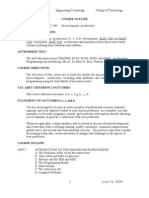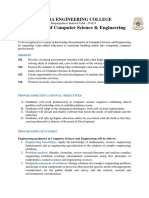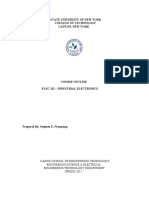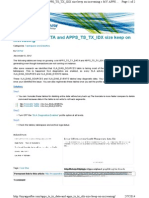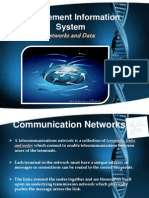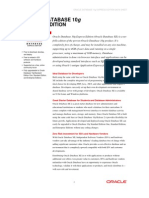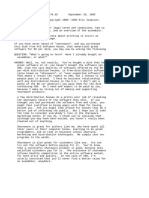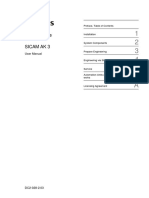Eln133 0
Eln133 0
Uploaded by
Takudzwa MCopyright:
Available Formats
Eln133 0
Eln133 0
Uploaded by
Takudzwa MOriginal Title
Copyright
Available Formats
Share this document
Did you find this document useful?
Is this content inappropriate?
Copyright:
Available Formats
Eln133 0
Eln133 0
Uploaded by
Takudzwa MCopyright:
Available Formats
ELN 133
DIGITAL ELECTRONICS
COURSE DESCRIPTION:
Prerequisites: ELC 112 or ELC 131 and MAT 145
Corequisites: None
This course covers combinational and sequential logic circuits. Topics include number systems,
Boolean algebra, logic families, medium scale integration (MSI) and large scale integration
(LSI) circuits, analog to digital (AD) and digital to analog (DA) conversion, and other related
topics. Upon completion, students should be able to construct, analyze, verify, and troubleshoot
digital circuits using appropriate techniques and test equipment. Course Hours Per Week: Class,
3. Lab, 3. Semester Hours Credit, 4.
COURSE OBJECTIVES:
Upon completion of this course, the student will be able to:
a. Perform decimal, octal, hexadecimal, and binary conversions.
b. Apply Boolean algebra to solve logic functions.
c. Identify, select, and handle display devices.
d. Analyze pulse circuits.
e. Analyze digital multiplexing circuits.
f. Analyze logic family interfaces.
g. Analyze logic switching circuits.
h. Analyze memory storage devices.
i. Select and apply signal generators.
j. Select and apply function generators.
k. Plan and execute projects.
l. Interpret catalogs to select equipment and components.
m. Interpret schematics to determine principal circuit functions.
n. Prepare parts list.
o. Prepare detailed circuit diagrams.
p. Layout wiring diagrams.
q. Sketch electrical drawings.
r. Prepare documentation for experiment and test procedures.
s. Prepare logic diagrams.
t. Understand VHSIC Hardware Description Language
u. Apply logic design circuits with Programmable Logic Devices
ELN 133: June 2013
OUTLINE OF INSTRUCTION:
I. Logic families and their characteristics
A. Evaluation of IC families
B. TTL
C. Characteristics of TTL gates
II. Basic TTL gate
A. Open and unused inputs
B. Wire-ANDing and open collector gates
C. Three-state devices
D. Strobed gates, expandable gates, and expanders
E. A AND-OR-INVERT gates
F. The EXCLUSIVE-OR / NOR gate
III. Parity checking
A. Comparison circuits
B. Parity checking and generation
C. More sophisticated error-correcting routines
IV. Multiplexers and demultiplexers
A. Multiplexers
B. Demultiplexers
C. Practical applications
V. Flip flops
A. The basic flip-flop
B. NOR gate flip-flops
C. NAND gate flip-flops
D. D-type flip-flops
E. Bistable latches
F. J-K master-slave flip-flops
G. Edge-triggered flip-flops
H. Timing charts
I. Direct SETS and direct CLEARS
J. Race conditions
K. Flip-flops parameters
L. Uses of flip-flops
M. Synchronizing flip-flops
N. Glitches
VI. Counters
A. Divide by N-counters
B. Ripple counters
C. Synchronous counters
D. Irregulars and truncated count sequences
E. IC counters
ELN 133: June 2013
F. UP-DOWN counters
G. Divide by N-circuits using counters
VII. Shift registers
A. Basic shift register
B. Serial inputs and parallel output shift registers
C. Parallel input and serial output shift registers
D. Parallel input and parallel output shift registers
E. Serial input and serial output shift registers
F. Universal shift registers
G. Applications
VIII. Computer Aid Design tools for the digital circuits
A. VHSIC Hardware Description Language
B. Design circuits with Programmable Logic Devices
REQUIRED TEXTBOOKS AND MATERIALS:
Floyd, Thomas. Digital Fundamentals. 8th ed.
Dueck, Robert. Digital Design with CPLD Application and VHDL.
STATEMENT FOR STUDENTS WITH DISABILITIES:
Students who require academic accommodations due to any physical, psychological, or learning
disability are encouraged to request assistance from a disability services counselor within the
first two weeks of class. Likewise, students who potentially require emergency medical
attention due to any chronic health condition are encouraged to disclose this information to a
disability services counselor within the first two weeks of class. Counselors can be contacted by
calling 919-536-7207, ext. 1413 or by visiting the Student Development Office in the Phail
Wynn Jr. Student Services Center, room 1209.
ELN 133: June 2013
You might also like
- PL-300 Exam Dumps FinalDocument260 pagesPL-300 Exam Dumps Finalvaddi bhargav100% (5)
- Digital Electronics - 2 Marks With Answers PDFDocument40 pagesDigital Electronics - 2 Marks With Answers PDFMANJU C S100% (24)
- Syllabus 2140910Document4 pagesSyllabus 2140910Hardik AgravattNo ratings yet
- PDFDocument4 pagesPDFArpit PatelNo ratings yet
- Lab Details ECE PDFDocument50 pagesLab Details ECE PDFFrew FrewNo ratings yet
- Gujarat Technological University: W.E.F. AY 2018-19Document4 pagesGujarat Technological University: W.E.F. AY 2018-19useless9925No ratings yet
- Gujarat Technological University: W.E.F. AY 2018-19Document3 pagesGujarat Technological University: W.E.F. AY 2018-19Alok MauryaNo ratings yet
- DSD Syll - Merged DSD GtuDocument8 pagesDSD Syll - Merged DSD GtuSandeep kumarNo ratings yet
- Syllabus - DigitalElectronics and MicroprocessorDocument2 pagesSyllabus - DigitalElectronics and Microprocessorrockin_ravi_vitNo ratings yet
- GTU Digital ElectronicsDocument3 pagesGTU Digital Electronicssjbv.hardik582No ratings yet
- Instrumentation Engineering Syllabus 141023Document5 pagesInstrumentation Engineering Syllabus 141023ravikoriveda123No ratings yet
- Electronics 4Document4 pagesElectronics 4drkhamuruddeenNo ratings yet
- SLTE Type B2 Course OutlineDocument8 pagesSLTE Type B2 Course OutlineAdekola AneyoNo ratings yet
- Logic Gates ExercisesDocument6 pagesLogic Gates ExercisesSachidananda SwarNo ratings yet
- Switching Theory and Logic DesignDocument4 pagesSwitching Theory and Logic DesignMoez Ul Hassan0% (1)
- VLSI Laboratory: Manual ForDocument80 pagesVLSI Laboratory: Manual ForCecilia ChinnaNo ratings yet
- Written Test A. Matching Type: Instructions: Match The Letters in Column B With The Numbers in ColumnDocument10 pagesWritten Test A. Matching Type: Instructions: Match The Letters in Column B With The Numbers in Columnopep77No ratings yet
- Digital System Design: L T P C 3 0 0 3Document4 pagesDigital System Design: L T P C 3 0 0 3Nishant KumarNo ratings yet
- Syllabus 4th SemDocument12 pagesSyllabus 4th SemBhartendu goyalNo ratings yet
- Experiment 7 FinalDocument5 pagesExperiment 7 Finalliddleme33No ratings yet
- EC6302Document107 pagesEC6302AJ ADNo ratings yet
- Course Outline Course: Caltalog DescriptionDocument3 pagesCourse Outline Course: Caltalog Descriptionvarunpunganur100% (1)
- Digital Electronics: Unit 1 FundamentalsDocument5 pagesDigital Electronics: Unit 1 Fundamentalslalit_kaushish333No ratings yet
- Bti 402 Digital ElectronicsDocument1 pageBti 402 Digital ElectronicsSanjay Kr SinghNo ratings yet
- Course File Final Heena A DigitalDocument23 pagesCourse File Final Heena A DigitalraghuippiliNo ratings yet
- EE204 Digital Electrncs N Logic DesignDocument3 pagesEE204 Digital Electrncs N Logic DesignsaniljayamohanNo ratings yet
- 2131004Document3 pages2131004Parthiv Oza MasterMindNo ratings yet
- Module Descriptor For Digital ElectronicsDocument4 pagesModule Descriptor For Digital ElectronicsTashi DendupNo ratings yet
- Department: ECE Staff Name: Logic Design Lab 10ESL38: Course PlanDocument7 pagesDepartment: ECE Staff Name: Logic Design Lab 10ESL38: Course PlansrijaNo ratings yet
- ACHP401Document4 pagesACHP401Anonymous 73gEYyEtLNo ratings yet
- Electronics Lab IIDocument3 pagesElectronics Lab IIVikram RaoNo ratings yet
- 8051 Microcontroller CourseDocument6 pages8051 Microcontroller CoursePappu SinhaNo ratings yet
- ADSD Lab Manual_241008_175247Document67 pagesADSD Lab Manual_241008_175247nithinnithinkm95No ratings yet
- Group Study - Computers QuestionnaireDocument5 pagesGroup Study - Computers QuestionnaireSheehan Kayne De Cardo100% (1)
- Digital Electronics Syllabus PDFDocument5 pagesDigital Electronics Syllabus PDFAvinash SinghNo ratings yet
- I - Sem - Syllabus - EE IoT - 2022-23Document8 pagesI - Sem - Syllabus - EE IoT - 2022-23Sourabh KumarNo ratings yet
- Computers Answer KeyDocument5 pagesComputers Answer KeyLorenz ArdienteNo ratings yet
- Electronica IndustrialDocument7 pagesElectronica IndustrialNetxi NoriegaNo ratings yet
- NIELIT Scientist B' Recruitment 2016 - Computer Science - GeeksforGeeksDocument15 pagesNIELIT Scientist B' Recruitment 2016 - Computer Science - GeeksforGeeksChristopher HerringNo ratings yet
- EE P51 Electronics Lab-IIIDocument2 pagesEE P51 Electronics Lab-IIIr gouthamNo ratings yet
- 5digital Signal Logic Design Lab - PDFDocument31 pages5digital Signal Logic Design Lab - PDFtanzir ahmedNo ratings yet
- Digital Design SyllabusDocument3 pagesDigital Design SyllabusRahul KumarNo ratings yet
- Digital LogicsDocument3 pagesDigital Logicsattitudeking565No ratings yet
- CSS Summative 1-3Document3 pagesCSS Summative 1-3koiNo ratings yet
- V.E.S. Institute of Technology Department of Instrumentation S.E/Sem III/Digital Electronics/2015-16Document5 pagesV.E.S. Institute of Technology Department of Instrumentation S.E/Sem III/Digital Electronics/2015-16VigneshRamakrishnanNo ratings yet
- First Periodical Test IctDocument9 pagesFirst Periodical Test IctClaire NotadoNo ratings yet
- HDL. London: Pearson Education.: Course SyllabusDocument2 pagesHDL. London: Pearson Education.: Course Syllabusdjun033No ratings yet
- Engineering Study Abroad Handbook 2023 2024Document114 pagesEngineering Study Abroad Handbook 2023 2024BRAHMJOT SINGH100% (1)
- 18CS33 ADE M1 NotesDocument65 pages18CS33 ADE M1 Notessuresh mariappanNo ratings yet
- 18cs33 Ade m2 NotesDocument37 pages18cs33 Ade m2 NotesharishNo ratings yet
- QB PhyandElecDocument6 pagesQB PhyandElecmuzammiltaj7989No ratings yet
- 3.1 Digital Electronics: RationaleDocument20 pages3.1 Digital Electronics: RationaleHari GNo ratings yet
- Elec 232Document6 pagesElec 232Mark HerrasNo ratings yet
- COC Level 4 Mechatronics Volume 2Document4 pagesCOC Level 4 Mechatronics Volume 2Nati Nop100% (1)
- Ece SyllabusDocument28 pagesEce SyllabusdebaratiNo ratings yet
- Solderless Breadboard Explorations: Unveiling the Wonders of Electronic PrototypingFrom EverandSolderless Breadboard Explorations: Unveiling the Wonders of Electronic PrototypingNo ratings yet
- Practical TTL Logic Gates: 74LS Integrated Circuits in ActionFrom EverandPractical TTL Logic Gates: 74LS Integrated Circuits in ActionNo ratings yet
- The Secret of Logic Gates: Unveiling the Power of Light Dependent ResistorsFrom EverandThe Secret of Logic Gates: Unveiling the Power of Light Dependent ResistorsNo ratings yet
- Electromagnetic Well Logging: Models for MWD / LWD Interpretation and Tool DesignFrom EverandElectromagnetic Well Logging: Models for MWD / LWD Interpretation and Tool DesignRating: 5 out of 5 stars5/5 (1)
- Build Switch and Logic Gates Using Transistors on the BreadboardFrom EverandBuild Switch and Logic Gates Using Transistors on the BreadboardNo ratings yet
- GROUP A - Symmetrical ComponentsDocument45 pagesGROUP A - Symmetrical ComponentsTakudzwa MNo ratings yet
- LECTURE 06 EENG405 Mobile Telecommunications Lecture 7& 8 - Introduction To Wireless Access TechnogiesDocument268 pagesLECTURE 06 EENG405 Mobile Telecommunications Lecture 7& 8 - Introduction To Wireless Access TechnogiesTakudzwa MNo ratings yet
- Zimbabwean ContextDocument3 pagesZimbabwean ContextTakudzwa MNo ratings yet
- Financial Statement: LogoutDocument4 pagesFinancial Statement: LogoutTakudzwa MNo ratings yet
- EENG302 Questions 1Document28 pagesEENG302 Questions 1Takudzwa MNo ratings yet
- Chapt 3 Principles of Static Magnetic FieldsDocument82 pagesChapt 3 Principles of Static Magnetic FieldsTakudzwa MNo ratings yet
- Chapt 2 Principles of Static Electric FieldsDocument57 pagesChapt 2 Principles of Static Electric FieldsTakudzwa MNo ratings yet
- GROUP E - Symmetrical ComponentsDocument45 pagesGROUP E - Symmetrical ComponentsTakudzwa MNo ratings yet
- Final Group A Power SystemDocument34 pagesFinal Group A Power SystemTakudzwa MNo ratings yet
- 01 Vector SqwarithmeticDocument8 pages01 Vector SqwarithmeticTakudzwa MNo ratings yet
- WQWQW Transient Effects and Bounce DiagramsDocument12 pagesWQWQW Transient Effects and Bounce DiagramsTakudzwa MNo ratings yet
- EE Sem 4 SyllabusDocument10 pagesEE Sem 4 SyllabusTakudzwa MNo ratings yet
- Lecture 4 HO 2022Document88 pagesLecture 4 HO 2022Takudzwa MNo ratings yet
- Ee301 Syllabus 1506072951Document1 pageEe301 Syllabus 1506072951Takudzwa MNo ratings yet
- The Art of Troubleshooting InformationDocument14 pagesThe Art of Troubleshooting InformationYojoNo ratings yet
- Cellular-Concept PPT PDFDocument35 pagesCellular-Concept PPT PDFSaurabh Nirala pandeyNo ratings yet
- AIN1501 Assesment Plan 2023 S1 FinalDocument6 pagesAIN1501 Assesment Plan 2023 S1 FinalZandileNo ratings yet
- Apps TS TX DataDocument2 pagesApps TS TX DataMarwan SaadNo ratings yet
- Pengantar Teknologi Informasi: Komunikasi Data Dan Jaringan KomputerDocument14 pagesPengantar Teknologi Informasi: Komunikasi Data Dan Jaringan KomputerJennie wuNo ratings yet
- SYSC3601 LABORATORY #3 (Summer 2009) Interrupts: The End of The Lab For MarkingDocument4 pagesSYSC3601 LABORATORY #3 (Summer 2009) Interrupts: The End of The Lab For Markingنفیسه احمدیNo ratings yet
- AJP Exp 4Document6 pagesAJP Exp 4Eske Tit100% (2)
- Management Information System: - Networks and DataDocument40 pagesManagement Information System: - Networks and Datarishisaxena92No ratings yet
- Final HSSC-I Model Paper Computer ScienceDocument9 pagesFinal HSSC-I Model Paper Computer Sciencebilalshah2237463No ratings yet
- Zym GM23 5RDocument18 pagesZym GM23 5RFabricio RubioNo ratings yet
- The 2016 US Contact Center Decision Makers GuideDocument363 pagesThe 2016 US Contact Center Decision Makers Guidetsc databaseNo ratings yet
- Advanced React InterviewDocument15 pagesAdvanced React InterviewTuấn AnhNo ratings yet
- Unit 4-Transform and Transaction Analysis - DFD-Structure ChartDocument5 pagesUnit 4-Transform and Transaction Analysis - DFD-Structure Chartchatterjeesoham2003No ratings yet
- Mastering BitcoinDocument260 pagesMastering Bitcoinsanjaygoel1No ratings yet
- Broadband PPT Presentation MTNL BSNLDocument35 pagesBroadband PPT Presentation MTNL BSNLtechcare123No ratings yet
- Kidneyreport 1.22 No Use and SequenceDocument30 pagesKidneyreport 1.22 No Use and SequencePrasad BirariNo ratings yet
- 10g OverviewDocument2 pages10g Overviewsheilaabad8766No ratings yet
- Workday Application & Pymetrics GuidelineDocument2 pagesWorkday Application & Pymetrics GuidelineMomin KhurramNo ratings yet
- NS-01 Firmware Release NotesDocument5 pagesNS-01 Firmware Release NotesDaniel ModicaNo ratings yet
- ProgrammeDocument5 pagesProgrammeFIONA CHATOLANo ratings yet
- Applying 5s On Your Computer: Argel Jermen A. JuanDocument23 pagesApplying 5s On Your Computer: Argel Jermen A. JuanArgel Jermen A. Juan100% (1)
- A86 ManualDocument167 pagesA86 ManualChristianNo ratings yet
- Chapter 12: Client/Server Systems: Basic ComponentsDocument19 pagesChapter 12: Client/Server Systems: Basic ComponentsAnonymous TvppppNo ratings yet
- Design and Implementation of A Computerized Hotel Business Billing Systemfcdd9f1d 0f7d 4c2d b4c6 958ddf4a2678Document61 pagesDesign and Implementation of A Computerized Hotel Business Billing Systemfcdd9f1d 0f7d 4c2d b4c6 958ddf4a2678MICHAEL ADEYEMONo ratings yet
- Cse Set A Dpco 22nov2024Document3 pagesCse Set A Dpco 22nov2024Nithya BathiNo ratings yet
- XAPAX SecurityDocument212 pagesXAPAX SecurityCraypalNo ratings yet
- Artificial Intelligence - CrosswordDocument2 pagesArtificial Intelligence - CrosswordcookecNo ratings yet
- Sicam Rtu PDFDocument260 pagesSicam Rtu PDFFabián SepúlvedaNo ratings yet
- TrainingGuide Geomatica OrthoEngineDocument174 pagesTrainingGuide Geomatica OrthoEngineArun PrasadNo ratings yet





















